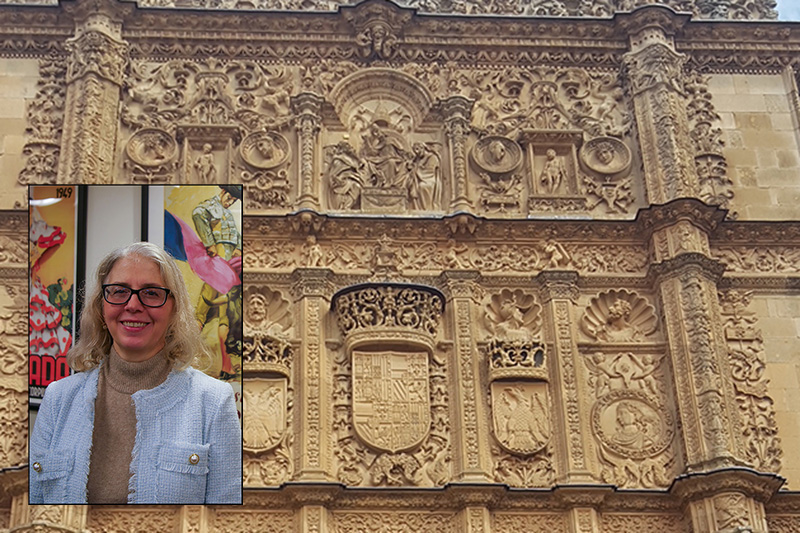


Finding home in a foreign land
Photo courtesy of Cristina Guardiola-Griffiths June 06, 2024
Taking students to her family’s country of origin helps a UD professor define what home means
Editor’s note: The Home Again series shares stories of University of Delaware faculty who have led study abroad programs to their home countries, offering unique perspectives and personal experiences to students.
Growing up as a first-generation American, Cristina Guardiola-Griffiths sometimes wondered where home really was. The associate professor of Spanish was born and grew up in New Jersey, to parents who had met at University of Zaragoza in the Aragón region of northeastern Spain. Living most of the year in New Jersey but spending her summers with extended family in Spain meant that Guardiola-Griffiths never felt like she fully belonged wherever she was.
“Spanish was my first language,” she said. “We’re definitely American, and we love this country that has given our family so many opportunities, but there is also a feeling of ‘where do I come from?’”
This uncertainty made it important to Guardiola-Griffiths to learn about her family’s country of origin, eventually leading her to follow in her father’s footsteps as a scholar of Medieval Spanish literature, receiving her doctorate from UC Berkeley. A member of the University of Delaware’s Department of Languages, Literatures and Cultures faculty since 2001, she has led study abroad programs to Spain for more than 15 years. Introducing students to the country’s cultural richness and unique regions and seeing the country through their eyes as first-time visitors has helped Guardiola-Griffiths understand that the idea of home is not limited to a single place.
She has led numerous programs to Salamanca, Spain, a medium-sized, walkable university town, much like Newark, Delaware. The University of Salamanca, the oldest university in Spain, has a long history with study abroad and an established international program for Spanish as a second language, so UD students take classes with local professors and students from all over the world.
“When you have a class with students from Germany or China or Japan, often the only common language is Spanish, and this provides a better experience for developing language proficiency,” she said.
As in much of Spain, the historic architecture in Salamanca reveals its complicated, multi-cultural history. During the Middle Ages, Christian, Jewish and Muslim populations lived alongside one another, making these lands less homogeneous than their European counterparts. Cities grew by building on top of old structures, resulting in layers of different building styles and cultural influences.
While beautiful, cobblestone streets, stairs and the lack of modern accessibility features like ramps that are common in the United States make navigating an old city especially difficult for those with mobility issues. But Guardiola-Griffiths discovered an unexpected similarity between the two countries from an experience with a student several years ago.
In summer 2018, Daniel Schaefer, who graduated in 2019 with degrees in Spanish and linguistics, participated in a Salamanca program led by Guardiola-Griffiths. Schaefer uses a wheelchair, so they needed to carefully plan the experience, mapping out trains routes and subway stops in advance so Schaefer would be able to get in and out of stations.
“Europe is not generally very kind to people who are in wheelchairs,” she said.
“People don’t realize that just a single step makes the difference between something being accessible or not,” Schaefer added.
They encountered some difficulties, but for the most part Schaefer was able to participate in the program along with everyone else in the group. Guardiola-Griffiths was surprised and pleased to learn how much cities in Spain have done to improve accessibility, and how easy it was for Schaefer to use the public transportation system to get around.
“It’s not something I ever would have noticed before,” she said. “When you live somewhere you don’t notice small changes until you have a reason to notice them. But culture is a living thing, so the society you remember from four, or even two, years ago doesn’t exist anymore.”
Schaefer appreciated the experience of having a faculty leader with such strong ties to the country.
“She understands both Spain and the United States so well, he said. “Her perspective was so valuable and informative.”
Schaefer still thinks about the experience regularly, and it helped ignite a desire to keep traveling and learning about different countries.
Schaefer’s experience in Spain is just one of the student stories that Guardiola-Griffiths points to in helping her recognize her second home in more meaningful ways.
“I like seeing students fall in love with these spaces and find that little bit of home in a foreign land,” she said. “It’s not me saying, ‘This is why I love it so much.’ It is the students growing and fitting within Spain, creating a community. It isn’t that Spain is my home — it’s that it becomes our home together.”
Contact Us
Have a UDaily story idea?
Contact us at ocm@udel.edu
Members of the press
Contact us at 302-831-NEWS or visit the Media Relations website

